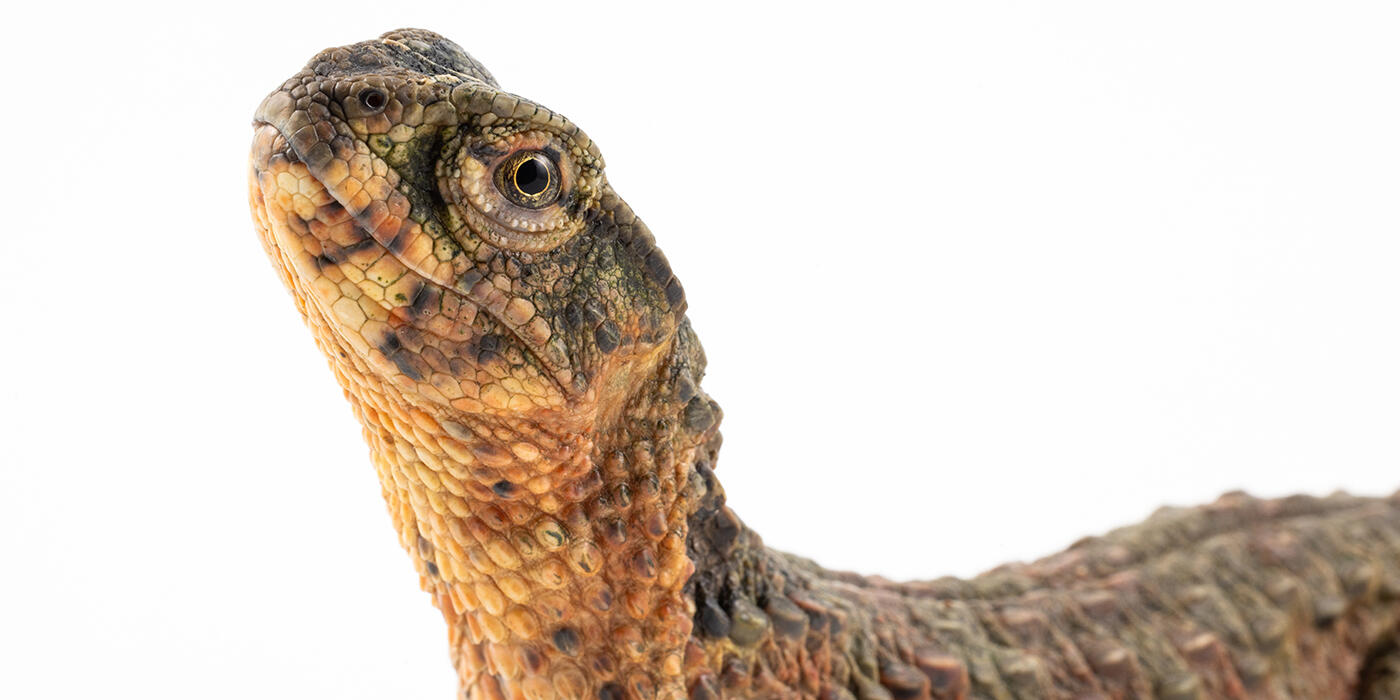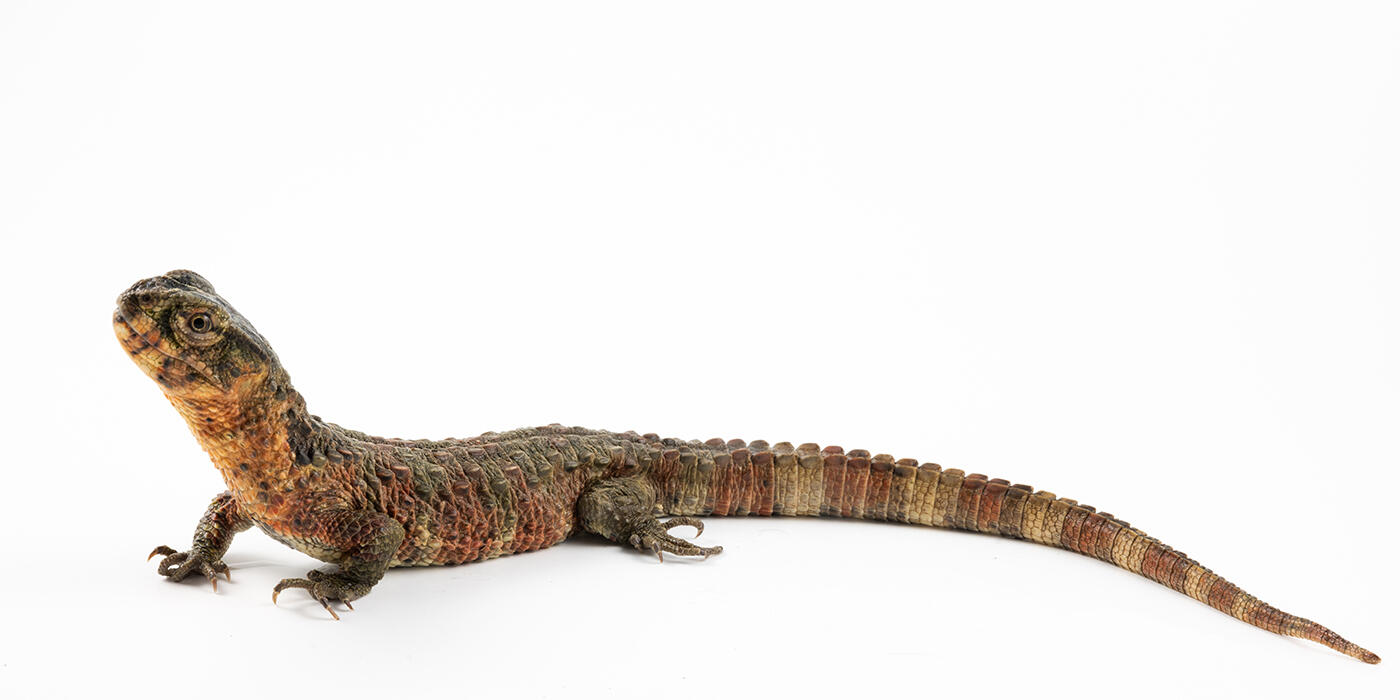Physical Description
The Chinese crocodile lizard is gray-brown with a yellow-tan underside and red-orange markings along its throat and sides, which gradually transition to alternating light and dark bands that extend to the tip of its tail. Hatchlings are deep brown with a lighter, tan head. Two rigid rows of scales extend down this lizard's tail, giving it a crocodilian look.
These reptiles are sexually dimorphic, meaning males and females look different. Males are typically larger and more colorful, with color vibrancy intensifying during the breeding season.
Chinese crocodile lizards are more likely to choose flight over fight. If it is possible to escape, they will jump into the water and use their powerful tail to propel themselves away from a threat. They are able to remain underwater for extended periods of time by regulating their respiratory rate.
However, if caught, they will go into a fit of violent struggle, defecating, hissing and biting to free themselves from a predator's grip.
Native Habitat
Crocodile lizards are native to southern China and Vietnam, where they live in subtropical forests near freshwater ponds and slow-moving streams. They prefer to inhabit areas with dense vegetation, which offers sufficient shelter and protection while resting.
Chinese crocodile lizards occur in elevations of 200 to 1,500 meters (650 to 4,900 feet) in China, and 400 to 800 meters (1,300 to 2,600 feet) in Vietnam. They seek out the shelter of rock crevices and tree holes between the months of November and March, when water temperatures dip below 60 degrees Fahrenheit (15.5 degrees Celsius).
Local extirpation of this species has occurred throughout its range, and populations are severely fragmented in China, with distances of over 10 kilometers (6.2 miles) separating localities.
Lifespan
Food/Eating Habits
This lizard's ability to dive into the water and remain submerged for extended periods of time is useful for escaping predators but also aids in hunting. It primarily eats invertebrates, including snails, tadpoles, insects, worms and larvae. At the Smithsonian's National Zoo, these reptiles are fed crickets, worms and snails.
Sleep Habits
The Chinese crocodile lizard is diurnal, meaning it is most active during the day. It frequently enters into a metabolic pause, where it remains motionless and unresponsive to stimuli for several hours at a time. This may be to conserve its caloric energy, especially when temperatures drop.
Due to this unique behavior, this reptile is sometimes referred to as the "lizard of great sleepiness" by indigenous people, which has led to the belief that Chinese crocodile lizards have the ability to cure insomnia.
Between November and March, water temperatures dip below 15.5 degrees Celsius (60 degrees Fahrenheit). To withstand these colder months of the year, these lizards go through brumation, a hibernation-like state which allows them to withstand extreme temperatures. During brumation, this otherwise solitary species may congregate together in rock crevices and tree holes.Social Structure
Reproduction and Development
These lizards reach sexual maturity at about age 3. During the breeding season, which occurs in July and August, the male's color increases in vibrancy. Females give birth to between two and 12 young after a nine month gestation period.
Chinese crocodile lizards are viviparous, giving birth to live young, and the newborn lizards are precocial, meaning they are born in an advanced state and can feed themselves almost immediately after birth. The parents do not care for the young.
Conservation Efforts
As of a 2014 analysis, Chinese crocodile lizards are listed as endangered on the International Union for Conservation of Nature's Red List. They are also protected under CITES Appendix II and managed under a Species Survival Plan in North America.
They are threatened by habitat loss, fragmentation and degradation due to logging, mining, damming and land encroachment driven by tourism. A decrease in forest cover results in fewer perch sites and the degradation of streams, which this species relies on. Tourism-driven encroachment is of particular issue in Vietnam, where an increase in roads and land use for agriculture has resulted in pollution throughout this species' range. Though some protected areas exist, extreme habitat degradation is still present outside of these regions.
This lizard's numbers have significantly declined due to harvesting and hunting for the pet and animal products trades. They are popular because of their vivid coloration and likeness to crocodiles. A CITES analysis showed that few Chinese crocodile lizards found in the pet trade were bred in captivity. Higher prices for wild-caught animals and for rare species, like the Chinese crocodile lizard, further incentivizes traders to seek wild populations.
Additionally, because of the belief that these lizards can cure insomnia, they are collected for use in traditional medicines. The over-extraction of wild-caught individuals is especially alarming, because there are only two subpopulations left, both of which are already under pressure.
At least half of the known populations of Chinese crocodile lizards occur outside of protected areas, and better protection of habitats is necessary for the long-term survival of this species. Additionally, further protection is needed from illegal harvesting inside of protected areas.
In 1996, the Association for Zoos & Aquariums formed the Lizard Advisory Group to help manage North American collections of rare and endangered lizards, encourage the formulation of breeding programs and create an international network for exchanging knowledge on lizards.
This group made the conservation of the Chinese crocodile lizards its top priority. The Chinese crocodile lizard is now under human care in North American institutions and has successfully been bred. National legislation has been proposed in Vietnam to list these animals as a protected species.
Help this Species
Practice ecotourism by being an advocate for the environment when you’re on vacation. During your travels, support, visit or volunteer with organizations that protect wildlife. Shop smart too! Avoid buying products made from animals, which could support poaching and the illegal wildlife trade.
Choose your pets wisely, and do your research before bringing an animal home. Exotic animals don’t always make great pets. Many require special care and live for a long time. Tropical reptiles and small mammals are often traded internationally and may be victims of the illegal pet trade. Never release animals that have been kept as pets into the wild.
Smithsonian's National Zoo and Conservation Biology Institute. (n.d.). Chinese crocodile lizard. Retrieved December 1, 2025, from https://nationalzoo.si.edu/animals/chinese-crocodile-lizard
Animal News

Giant Panda Qing Bao Gets a Checkup ›

7 Spooktacular Animal Facts for Halloween ›


